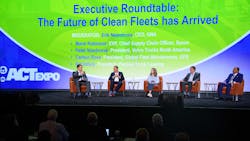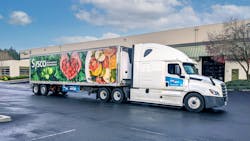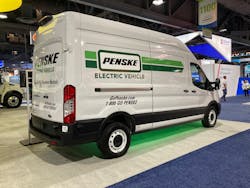Like it or not, zero-emission commercial truck technologies are here, and they are only going to gain more traction over time. That was at least the sentiment that permeated this year’s Advanced Clean Transportation (ACT) Expo.
Even as that momentum grows, diesel fuel isn’t going away anytime soon, as truck and engine manufacturers continue to invest in making trucking’s main fuel source more efficient for fleets.
Volvo Trucks North America, for example, plans to continue moving diesel technologies to the market that will help improve fuel economy, VTNA President Peter Voorhoeve explained during an ACT Expo roundtable discussion on the future of clean fleets.
“Ultimately, what will happen is we will move more toward fossil-free fuels,” Voorhoeve said. “We will still need an internal combustion engine. How much will be renewable diesel or renewable natural gas is difficult to determine right now, but there will be space. We will invest in all technologies to reduce emissions.”
Art Vallely, president of Penske Truck Leasing, also agreed diesel will be around for a while, particularly as charging infrastructure for electric vehicles remains the top industry and societal challenge to overcome.
See also: Truck OEM execs talk EV charging infrastructure pain points
Vallely, as well as fellow panelists Marie Robinson, EVP and chief supply chain officer for Sysco Corp., and Carlton Rose, president of global fleet maintenance at UPS Inc., emphasized the importance of developing partnerships to accelerate the fleet-electrification movement in the U.S.
“As we’re looking to expand our utility network in California, there are 47 locations that we are trying to get into, and we are getting timelines of 18 to 36 months before we’ll be able to get charged,” Vallely said.
For Sysco’s fleet of some 14,000 tractor-trailer and van combinations, Robinson called the company’s path to zero emissions a journey with no “on and off switch.” Sysco has set a science-based climate goal to reduce emissions by 2030, which includes the electrification of 35% of its U.S.-based fleet.Panel moderator Erik Neandross, CEO of Gladstein, Neandross & Associates, the firm that puts on the ACT Expo, asked panelists if they could wave a magic wand to bring zero-emission technologies to scale sooner, what would their ideal journey look like?
Rose first pointed to parts availability and adopting long-term strategies for procurement.
“We’ve seen parts go up 300% to 350%,” he stressed. “We can’t stay there. There are [suppliers] taking advantage, and we don’t have short-term memories of those people.”
When it comes to bringing zero-emission truck technologies to scale, Rose said he would like to see more stakeholders play follow the leader.
“The OEMs are working hard to bring this technology forward,” he suggested. “It takes everyone. It takes efforts, regulations, and having the availability to purchase.”
For Vallely, waving a magic wand would result in a sensible total cost of ownership model for battery-electric and hydrogen fuel-cell commercial vehicles. Infrastructure also is a must, he added.
“For any of this to be possible, we need secure, stable, and efficient electrical grids across the world that we can depend on and not have to worry about when there’s a 110-degree heat wave in Houston,” Sysco’s Robinson pointed out.
She and Volvo's Voorhoeve emphasized that regulatory agencies working together and providing a reasonable regulatory framework also is necessary.
“We'd like there to be a smooth welcoming on-ramp for the electric vehicles. We’d like a graceful off-ramp for diesel vehicles so that from a commercial perspective, we are not put into a position where we’re having to overinvest on the diesel side, which limits our ability to invest on the electric side,” Robinson said.
Carbon neutrality commitments
State and federal regulations, along with corporate sustainability movements, have prompted fleets to begin shifting from traditional fuels to more near-zero—and ultimately zero—emission technologies.
See also: More fleets are adding clean vehicles, report finds
UPS, for example, has committed to carbon neutrality by 2050. VTNA, on the other hand, wants half of its vehicle offerings to be zero-emission trucks by 2030, with an end goal of all sales being 100% zero emission by 2040.
“We are very tactical at how we do things,” Rose said of the UPS commitments. “We know it takes collaboration with everyone out there.”
“Right now, demand is over supply,” he added. “When we get ready to replace a vehicle, we constantly look at our sustainability goals. My responsibility at UPS is to be picky—whether it be CNG, LNG, electric, hydrogen, whatever, we look at all those disciplines. We are agnostic when it comes to the technology to meet our goals.”
When building out Sysco’s long-term financial plans, Robinson said the company understands zero-emission vehicles will be an incremental cost above and beyond traditional vehicles.
Sustainability has been a strong corporate commitment of Penske’s for quite some time now as well. In 2018, Penske became the first commercial fleet in North America to take delivery of a fully electric truck from Daimler Truck North America, the company stated. Since then, Penske has been running other electric vehicles from various OEMs in North America.Vallely explained that Penske has some 20,000 full-service lease customers, including some of the largest fleets in America.
“We have the type of customers that are pushing us and looking at [electrification] from the perspective that we need to lead in this space,” he said. “And they want it for all the right reasons.”
He noted that 80% of lease customers rely on Penske to test as many electric vehicles as possible. “We are able to share with them for each of their individual applications what makes the most sense now and what might make the most sense next year,” Vallely said. “Some of those decisions come down to timing, as we wait for some of the infrastructure to catch up with some of the OEM production.”
About the Author

Cristina Commendatore
Cristina Commendatore is a past FleetOwner editor-in-chief. She wrote for the publication from 2015 to 2023.


